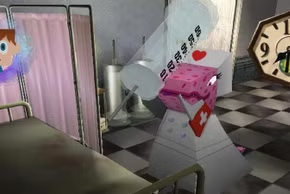
In Gregory Horror Show, players find themselves trapped in a surreal and unsettling hotel run by Gregory, a talking mouse with sinister intentions. The player becomes a guest who must escape by collecting the bottled souls of the hotel’s bizarre residents, each of whom represents a twisted caricature of human flaws and fears. While the cel shaded, cartoon visuals suggest whimsy, the game’s underlying tone is dark and oppressive, blending absurdity with psychological unease as the player navigates an environment where safety is always uncertain.
Released in 2003 exclusively for the PlayStation 2, Gregory Horror Show was developed by Capcom in collaboration with the creators of the Japanese CGI anime series of the same name. The game takes the quirky but unnerving world of the show and transforms it into an interactive survival horror experience. Players are tasked with outwitting the hotel’s eccentric residents, each guarding a soul bottle, while uncovering the mystery of their own entrapment. Though the game never saw wide release outside of Japan and Europe, it carved out a cult following for its bizarre style and its unique interpretation of horror through surreal comedy and dread.









Gameplay
Gameplay in Gregory Horror Show revolves around stealth, exploration, and strategy rather than direct combat. Players must carefully observe the behavior of the hotel’s residents, track their routines, and find the right opportunities to steal their soul bottles. Once a bottle is stolen, the guest becomes hostile and actively hunts the player throughout the hotel, creating tense cat and mouse encounters. With limited places to hide and the constant threat of discovery, survival depends on careful planning, timing, and nerve. The game mixes traditional survival horror tension with mechanics more akin to stealth puzzle gameplay.
Visuals & Style
The game employs cel shaded graphics, giving it a cartoonish yet uncanny aesthetic that both disarms and disturbs players. The cheerful animation style clashes with the sinister undertones of the setting, amplifying unease by turning something seemingly harmless into a vessel for horror. Character designs are grotesquely whimsical, with exaggerated features and surreal personalities that hide malicious intent. The atmosphere is further enhanced by eerie music and sound design, which emphasize isolation and dread in a hotel that feels alive and hostile.
Importance in Survival Horror History
Gregory Horror Show is important in survival horror history for its willingness to defy genre conventions. At a time when many horror games were leaning toward realism and action, it demonstrated that horror could also emerge from surrealism, dark humor, and psychological discomfort. By forcing players into situations where they had to stalk or be stalked, the game expanded the boundaries of survival horror beyond gore and monsters, showing that absurdity itself can be terrifying. Its originality has inspired appreciation as a cult classic, and an example of how the genre can experiment with tone and style.
Reception vs Historical Value
At release, Gregory Horror Show received mixed reviews, with critics praising its originality, atmosphere, and unique art style, but some criticized its repetitive gameplay and niche appeal. Despite this, the game gained a loyal fanbase, particularly among players who appreciated its willingness to take risks. Historically, it has been re-evaluated as an overlooked gem that blended humor and horror in a way few titles dared. Its cult status ensures it remains discussed as one of the most unusual and imaginative survival horror games ever made.
Availability & Collectibility



Gregory Horror Show was released only on PlayStation 2 in Japan and Europe, never making its way to North America. Because of this limited release, physical copies have become rare and collectible.
Trailer:
